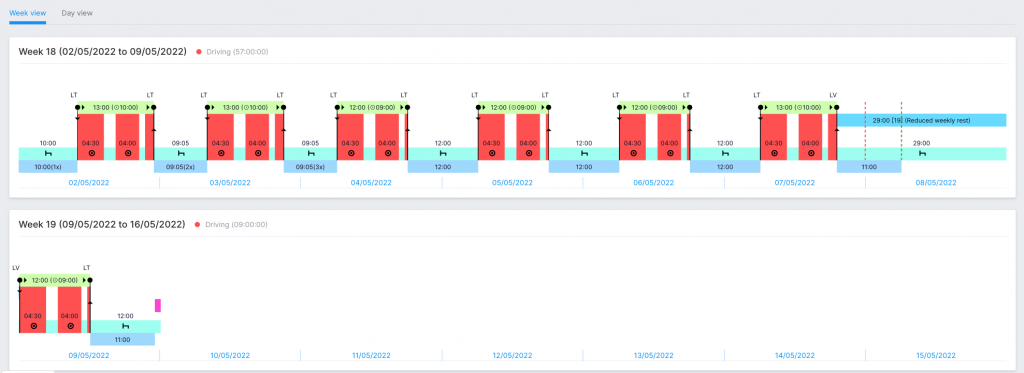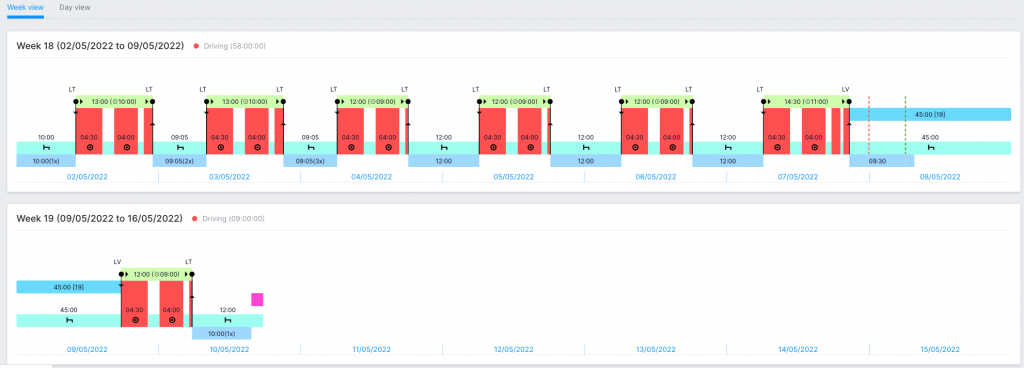
Mobility Package regulation: possibility to extend driving time
A while back we embarked upon a journey unravelling and explaining the ins and outs of the Mobility package regulations in a short blog series. Our goal - to see what's changed, how's that reflected in the Tachogram platform and simply help anyone looking for a bit of guidance on the matter. In this article, we'll cover the last of our topics in the series by looking at the possibility of drivers extending their driving time when returning to the employer’s operational centre or the driver’s place of residence.
The new rules and their scope
If you've been following us through the previous blog posts, by now we've covered several cases regarding weekly rests and reduced weekly rests as well as the different instances drivers can legally take advantage of, while at work. With all of these changes, legislators have also introduced a new provision to the mix, allowing drivers to exceed their driving time to reach home or the employer's base.
The aim of this is to ensure that drivers returning home (whether that be the company's place of establishment or the residence of the driver) can finish their job and take a well deserved and uninterrupted rest.
The point of discussion lies within Article 12 of EC Reg. No 561/2006, and while the rules seem perfectly clear at a glance, there are some things we should take a closer look at.
Only exceptional circumstances
First and foremost, it's important to note that the provision is included under the chapter of the regulation regarding exceptions, meaning that this cannot be considered common practice and used on a regular basis. Here's a further explanation established by the European courts detailing what qualifies as an exception:
“This article does not authorise a driver to derogate from the Regulation for reasons known before the journey commenced. It is designed to enable drivers to deal with cases where it unexpectedly becomes impossible to comply with the Regulation during the course of the journey, that is in situations of abnormal difficulties, independent of the will of the driver and apparently unavoidable that may not be anticipated, even if all due care is taken.”
And while the rules on extending driving time are new, Article 12 already established that exceptions can be made in cases where you'd need to ensure the safety of persons, the vehicle or its load. This, however, only meant reaching the nearest rest stop. Today, the same reasoning can be provided to reach home.
Only where road safety is not jeopardised
You'll also notice that the rule begins with: “provided that road safety is not therefore jeopardised”. What does that mean? As we see it, the following exceptions can only be applied, if the driver can assure that his performance on the road will not be hampered. For example, if you'd extend a journey to reach home while feeling extremely tired or unwell and cause an accident, on top of the damage, you'd also potentially be held liable for breaking driving and rest time rules.
Practical applications
As the new provisions contain nuances that are important to discuss, we've chosen to include direct quotes of paragraphs and follow-up with a short comment.
Exceed driving time by one hour
“Provided that road safety is not thereby jeopardised, in exceptional circumstances, the driver may also depart from Article 6(1) and (2) and Article 8(2) by exceeding the daily and weekly driving time by up to one hour in order to reach the employer’s operational centre or the driver’s place of residence to take a weekly rest period.”
When extending your driving time by one hour, you must remember about other rules that come into play. Article 6 of EC Reg. No 561/2006 says that daily driving time shall not exceed nine hours (may be extended to 10 hours twice a week), weekly driving time shall not exceed 56 hours, and total accumulated driving time during any two consecutive weeks shall not exceed 90 hours.
Notice that the new provision mentions exceeding daily and weekly driving time, but not the 90 hour limit set for two consecutive weeks. This means that if you're at the end of your two week limit, the possibility to extend your driving time under these conditions does not apply, and this will be registered as a violation.

Exceed driving time by two hours
“Under the same conditions, the driver may exceed the daily and weekly driving time by up to two hours, provided that an uninterrupted break of 30 minutes was taken immediately prior to the additional driving in order to reach the employer’s operational centre or the driver’s place of residence for taking a regular weekly rest period.”
In this case, prior to beginning your second hour, you are required to take a 30 minute break. Seems simple enough, but practically these situations won't happen often and will happen unexpectedly, which is why you may not have a pre-planned parking place required to take the break. Our advice - take a quick look at your options, before starting your first hour.
Looking further, you'll notice that in cases where a two hour extension is added to your driving time, it must be followed by a regular weekly rest period, as opposed to the previous case, which allowed for either a reduced weekly rest or a regular weekly rest.

While Art. 12 does allow departing from the rules on daily rests laid down in Art. 8(2), it does not seem to apply for daily rest periods in multi-manning cases. So regardless of whether additional driving time is added to a driver's timetable in order to reach home or the operational base, the daily rest shall be taken within 30 hours of the last rest period.
Finally, note that the exception prescribed in Art. 12 regarding daily driving time does not apply in cases where night work* is involved. Art. 7(1) of Directive 2002/15/EC explicitly notes that if night work is performed, the daily working time cannot exceed 10 hours in each 24 hour period.
*Night work is any work performed during night time, i.e. a period of at least four hours, as defined by national law, between 00.00 hours and 07.00 hours.
Don't forget to make a printout
If you find yourself in a situation, where you're unable to make it home, because of circumstances beyond your control, remember to make a printout once you've reached your destination. Similarly to other deviations, you're required to make a written note on the back of the printout, explaining what the circumstances were, and be sure to hold on to it for the next 28 days in case there's a roadside check. Otherwise, you might get fined for violating the driving and rest time rules!
In these circumstances you'll also notice that your digital tachographs will most likely show these as violations. This is where Tachogram users can benefit, as our team has implemented all the Mobility package regulations in the system, making sure to always properly reflect where you stand.
Special rules on compensations
“Any period of extension shall be compensated by an equivalent period of rest taken en bloc with any rest period, by the end of the third week following the week in question.”
Finally, such exceptions come with their own rules on how to compensate for the additional time spent on the road. Luckily, they're very flexible! In short, you make up for the time spent - one or two hours, respectively - together with any other rest period, may it be daily or weekly. Just make sure you do it by the end of the third week after the fact! For more on compensations, take a look here.
We've officially reached the end of the blog series and want to remind you that our team is always on top of any legislative changes, making sure you're always driving according to the current driving and rest time rules!
If you're new here and think Tachogram could ease your daily workload, make sure to take advantage of the 14-day-free trial and see first-hand how it can help!